RAGE
winter 2023

fem newsmag
Rage is often associated with violence, expressed physically and directly. It’s something that can be experienced very intensely but intimately other times.



Women and femmes have always been expected to suppress their rage. For women of color, emotions are racialized, and we are expected to simply take the gaslighting and microaggressions that we encounter daily.
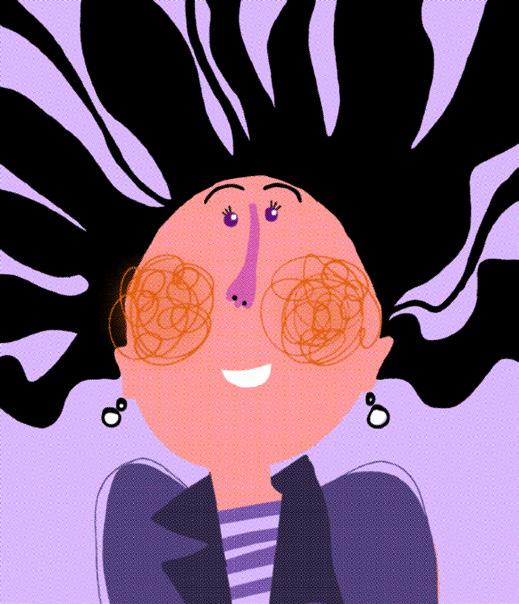
In media, rage is restricted in its temporality and who can express the sentiment.
Women and femmes have always been expected to suppress their rage. For women of color, emotions are racialized, and we are expected to simply take the gaslighting and microaggressions we encounter daily. Our emotions are even sexualized or fetishized, not taken seriously or silenced by the cisheteropatriarchy. Even in media, rage is restricted in its temporality and who can express this sentiment. In the age of movies Pearl, Black Swan, and Gone Girl, feminine rage is narrowly defined, and within the confines of masculine interpretations of anger.
In the age of movies Pearl, Black Swan, and Gone Girl Rage is often associated with violence, expressed physically and directly. It’s time to radically reclaim rage. As BlPOC, working class, and queer communities have formed ways to rage toward collective liberation, it’s imperative to honor and build on these tactics.
another. While rage isn’t the only outlet for revolution, the shared rage amongst people in pain, mourning, or exhaustion continues to shape how we approach action. Individual rage in reaction to the pandemic, global news, ongoing conflicts, and tragedy is ultimately tied to legacies of struggle and genealogy of experience. We must consider the alternative ways in which we can process our rage and emotions through anti-capitalist and decolonial means.
Marginalized communities continue to transform and utilize healthy rage in resistance to violence and in solidarity with one another. While rage isn’t the only outlet for revolution, the shared rage among people in pain, mourning, or exhaustion continues to shape how we approach action. Individual rage in reaction to the pandemic, global news, ongoing conflicts, and tragedy is ultimately tied to legacies of struggle and genealogy of experience. We must consider the alternative ways in which we can process our rage and emotions in a capitalist, individualist society.
It’s time to radically reclaim rage.
Rage is dedicated With love,
As BlPOC, working class, and queer communities have formed ways to rage toward collective liberation, it’s imperative to honor and build on these survival tactics. Marginalized communities continue to transform and utilize healthy rage in resistance to violence and in solidarity with one
Rage is dedicated to all marginalized peoples across the globe, who continue to transform what it means to resist.
ii
portrait by katelynn perez
FEM2023 iii Rage Playlist.....................................................................1 Rage Photoshoot.............................................................2 Dear Nepo Mom, .............................................................3
Asian American Rage.....................................................6
Femme Rage: What Angry Album Are You?!...........9
Raging and Rotting......................................................13
Metaphors of a Mad, Black Woman.........................15
by Amanda La, design by Katelynn Perez
by Jalyn Wu, design by Erin Choi
by Marie Olmedo, design by Erin Choi
by Gwendolyn Hill, design by Ashley Luong
by Kaycee Stiemke, design by Kaycee Stiemke

RadioRage RadioRage RadioRage RadioRage RadioRage RadioRage 1 Kill Bill by SZA 2 Army of Me by Bjork 3 Under the Table by Fiona Apple 4 Brand New City by Mitski 5 Differences by Baby Tate 6 Not Nice by Megan Thee Stallion 7 Bust Your Windows by Jazmine Sullivan 8 NDA by Megan thee Stallion 9 Smack a Bitch by Rico Nasty 10 Boyish by Japanese Breakfast 11 Underrated Popstar by Alice Longyu Gao 12 Rid of Me by PJ Harvey 13 Boys a liar Pt. 2 by Pinkpantress (ft. Ice Spice) RAGE RADIO PLAYLIST RAGE RADIO PLAYLIST RAGE RADIO PLAYLIST 1
RAGE PHOTOSHOOT
our photoshoot is performed quarterly per issue. this photoshoot explored the expressiveness and abstract nature of rage. one of those methods is collaging, and as I compiled the photos, I found myself digging deeper into the color, texture, and vibrancy of RAGE.

RAGE RAGE RAGE RAGE RAGE SEE MORE WORK FROM THE PROJECT ON OUR INSTAGRAM!
2023 2
RAGE RAGE RAGE RAGE
-cass FEM
Dear Nepo Mom
By Amanda La
Dear Nepo Mom is FEM’s advice column where Nepo Mom will answer any and all nepo baby questions submitted by the baby darlings of Hollywood.
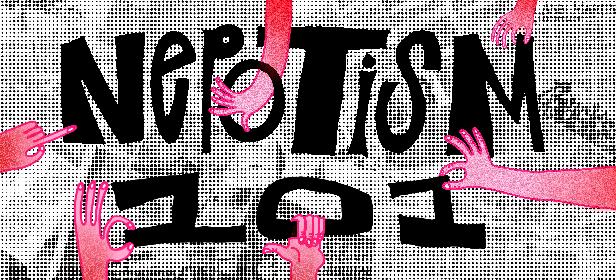
Dear Nepo Mom,
Help! I want to break into the entertainment industry like my parents. What can I do? How can I let everyone know that I’m a nepo baby? #JustWantThatFame
Sincerely, Super New Baby Nepo
Dear Super New Baby Nepo, Options, options, and even more options for what you could do! À la Hailey Bieber, you could show the world your privilege by wearing a “Nepo Baby” tee. Be warned of the backlash you might get — the little tongue-in-cheek might make you look tone deaf if people don’t have a sense of humor. If this doesn’t work, you could convince your parents to let you show up on the red carpet with them. But if you REALLY want a job, you could start off with modeling or maybe ask to get casted in that new show one of your parents or their friends are producing? Don’t worry, the cameras will LOVE you.
3 3
design by katelynn perez
Best of luck getting your name out there (not that you’ll need it)!
XOXO, Nepo Mom
Dear Nepo Mom,
If my parents aren’t A-listers, am I still considered a #nepobaby ?

Sincerely, Confused
Dear Confused,
The answer is: it depends! Nate Jones, describes a “nepo baby” (short for “nepotism baby”) as someone who is “the child of a celebrity,” while others will insist that it’s anyone with a familial connection
to the industry. Of course, it’s more complex than that. Having a random extra as a parent probably won’t do much for your career compared to having parents with actual connections that could sway certain hiring decisions and finance your Insta fame. At the end of the day though, don’t worry about it. If you are one, you’ll probably be labeled as one by the people on the internet. Afterall, you don’t get to choose the nepo life, the nepo life chooses you!
XOXO, Nepo Mom
Dear Nepo Mom,
I’m tired of everyone calling me spoiled and entitled! I’ve worked so hard to get here and people don’t understand! They keep say-
FEM2023 4
ing my acting’s mid!
Sincerely,
Started from the Top, Still at the Top
Dear Started from the Top, Still at the Top,
Whatever you decide to do — definitely avoid going the Lily Allen route and tweeting “the nepo babies y’all should be worrying about are the ones working for legal firms, the ones working for banks, and the ones working in politics.” That will make you come off as ignorant and just so not cool. First, maybe acknowledge that your parents being who they are definitely gave you a leg up in the industry. Whether you believe it or not, fake it till you make it. Do you think a regular person could be like Brooklyn Beckham and randomly decide to be a chef, photographer, or whatever career path he’s chosen each time he’s bored? Not likely.
You have access to resources that most people don’t — outside of job opportunities, it also includes all the expensive products you get to use, treatments you can afford to get, and how YOU help to set the standards. USE THEM AND SLAYYYY. If you still want to be upset, say it on a private account or your close friend’s story so that you won’t be canceled. DEFINITELY DO NOT throw an entitled tantrum and remind people that you’re a nepo baby, you might get less hate about it (probably won’t happen). But think about the positive: bad publici-
ty is still publicity.
XOXO, Nepo Mom Dear Nepo Mom, My parents aren’t Hollywood stars, and I don’t want to be either. But can I still be famous? Is that even possible? What can I do?
Sincerely,
Just an Unknown
Dear Just an Unknown,
If you don’t try, you’ll be irrelevant forever! It’s all about the name recognition babes. Look at Phoebe Gates or Eve Jobs whose fathers were tech moguls and definitely not Hollywood actors. Or, you can follow in whatever footsteps that your parents are in and make your name big in that industry. Plenty of nepo babies in the sports field too, think big! There’s a world bigger than just the entertainment industry.
XOXO, Nepo Mom
And that’s a wrap for this week’s advice. Don’t forget to submit any questions you have and you might just get a response back. See you next week! XOXO, Nepo Mom.
5
Asian American Rage
by Jalyn Wu
Content Warning: Misogyny, anti-Asian violence, racism, gender-based violence
It’s time to get angry at the world! You’ve heard that before.
ANGER! RAGE AGAINST THE MACHINE! Because there’s a lot to be angry about.
I guess no one realizes that I’ve BEEN angry. At everything. It’s hard to notice because everyone deals with anger differently. For better or worse, society has taught us how to handle our rage in “tolerable” ways since birth. But rage is not inherently accessible to every group of people — BIPOC in particular are seen as violent, evil and dangerous, while Asian people are seen as passive and submissive: “effeminate” men and “docile” women.
My mom taught me not to cry. This made me cry harder. Heartbreak was supposed to translate into bullet journaling, face masks and sad Taylor Swift songs. Failure was meant to look like moving forward and working harder.
As I grew older, I began getting angry at politics. I saw school shootings addressed with only “thoughts and prayers” and politicians on TV
calling for truth and justice (I was never really sure what they meant.) I’d ponder that question when doing lockdown drills. I learned the truth when Donald Trump was elected to office. He was an embodiment of the dystopian electoral politics of the United States: a populist pundit that shrewd commentators, reporters and bureaucrats alike could project their policy agendas onto. I realized that there was no truth nor justice, nor did that matter: our media, politics and education systems thrive off of white supremacy, and seek only to benefit those in positions of power.
For starters, these systems emphasize peaceful protest over any other form of social resistance. Consider the Black Lives Matter protests after the murder of George Floyd. Media coverage called activists “rioters” and “thugs” and portrayed the events as violent. The January 6 insurrection, by contrast, was embraced as “civil disobedience” and “patriotism.”
But nowhere had I ever seen Asian rage. Protests never highlighted a wide range of Asian emotions. Violence against Asian people wasn’t unheard of, sure, but I didn’t ever hear of unified anger or rage in Asian American communities in response. Mostly, my community was
FEM2023 6
praised for keeping our heads down and working hard to be accepted.
I knew then what I knew now: I occupy a perpetually foreign position in America. No matter what injustices are done to me, no matter how many times I’m pushed down and get back up, it won’t matter. That’s what “truth and justice” meant: double standards. Every part of my life, from interpersonal to macro political interactions, felt like hypocrisy. Broken promises.
Eventually, I spiraled into psychological exhaustion. I became apathetic to everything around me. I got super pessimistic — I started seeing it everywhere. I saw it in my mother when she explained for the hundredth time why she was scared to divorce my father. I saw it in my cousin when she confessed feeling burned out in her picture-perfect ca-
reer.
I saw it in the mirror this morning. In my community, gendered violence starts from home. Our Asian mothers don’t consider divorce an option, facing immense familial and cultural pressure to stay in unhappy marriages. And while patriarchal structures are at the root of this unfair pressure on women, they also have negative consequences for men. Toxic masculinity in Asian communities directly contributes to harmful physical and emotional environments for Asian men. Too often, men are left to deal with their rage alone. It’s my brother that refuses to see a therapist, my neighbor that spends more time watching TV than spending time with his wife, my father that left.
Sometimes, they’re driven to im-
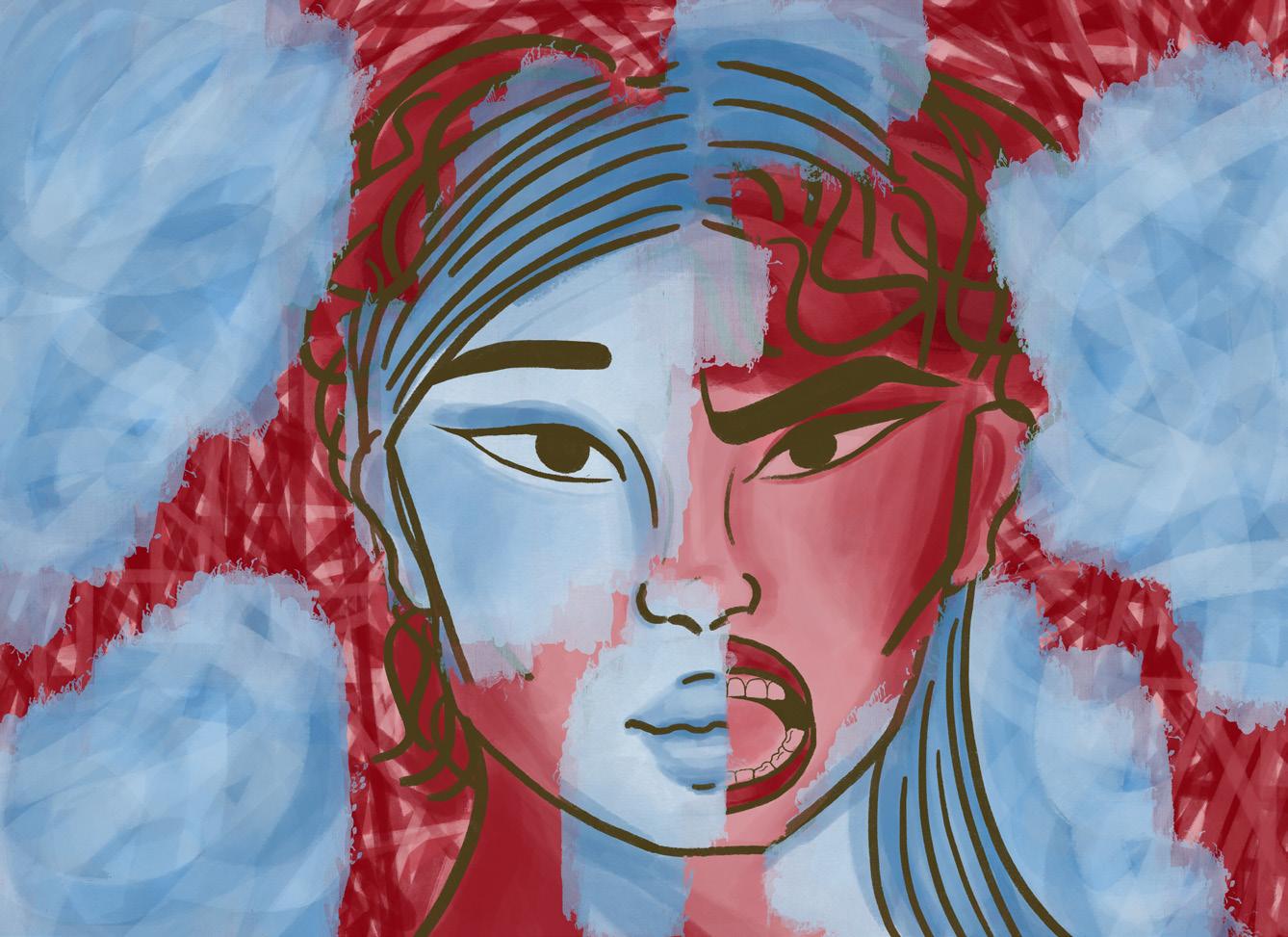
7
design by erin choi
plode and silently suffer through mental health issues. Too often they explode and direct their violence towards others. Their rage goes to anyone from domestic partners to strangers in the public sphere to their own children.
Consider the life of Asian man Elliot Rodger who murdered six people in 2014, two of them women, in a violent display of misogynist rage. According to his 140 page manifesto, women were both the object of his desire and of his hatred. I felt appalled as a young Asian woman to know that my body was one meant for inherent sexualization and fetishization, and that it was somehow all my fault.
It should go without saying that there is no justification for violence against innocent people as a response to rage. Rage that harms others, whether mentally, emotionally, or physically, is counterproductive and needlessly detrimental. Some might point to policing and the US criminal justice system as a solution to “punish” violence. Yet, macropolitics is part of what rips communities apart and causes rage to begin with.
Alternatively, I rage for a world of peace: of community care, of reparative and transformative justice, of joy.
Rage is not meant to be individual — especially for cultures with more collective values. The same communities that can tear us down should instead be safe spaces for us to share and reflect our ideas freely.
That’s part of why our rage has been co-opted or stamped out whenever it occurs. Those in power fear our collective action because it threatens the very structures they stand on.
Anger inherently disrupts the status quo: it’s an individual struggle to feel something, to do something and be a part of something liberatory. I advocate for a method of rage that meets no constraints, no principles, no justifications. I like the idea of being incomprehensible, like Chinese women screaming and creating commotions in courtrooms while being tried as “prostitutes” in 1854. I envision a world of collective action, like the sex workers that organized funds and vigils for the victims of the Atlanta spa shootings early 2021. Grassroots, community oriented and meaningful.
I know it creates discomfort to rage. But I just want to reach the point where I’m comfortable creating discomfort, rather than being forced to internalize it. I want to start speaking up for myself, and I want people around me to respect me more for it. I want to tell my mom that she means the world to me, and I want her to say she’s proud of me. I want to interrupt my racist uncle at the dinner table and I want to cut out my sexist friends. I want to be seen as more than just a simple stereotype: docile and submissive. Instead, I’m ready to embrace the real me: multifaceted and complicated.
No matter what you’re angry about, will you join me?
FEM2023 8
1Which instrument would you want to smash to pieces after your first sold-out hometown concert?
a. A drum set (while screaming)
b. Electric guitar
c. Pots and pans
d. I’d rather smack someone honestly.
e. A squeaky-sounding violin
f. A saxophone
g. A baseball bat
2Which would you rather be described as: jealous or crazy?
a. Being lonely is worse tbh…
b. There’s nothing wrong with either.
c. He don’t give a shit about me, so I dont give a shit about him.
d. You’re probably jealous of my Audi.
e. Both are just misogynistic phrases used to describe emotional women
f. I’d rather be crazy.
g. Being in love is worse.
Femme Rage: Album are
3After a long and tiring day, what helps you best deal with your frustrations?
a. Screaming to my favorite indie punk girl band
b. Watching one of my favorite cult classic movies
c. Destressing and hanging out with my pets
d. Putting some ice on and going out with my besties
e. Going to the supermarket and getting some ice cream
f. Making some lemonade
g. Going on a walk and yearning
4If you and your friends were to start a band, from whom would you draw most of your inspiration?
a. Blink-182
b. Sonic Youth
c. Joni Mitchell
d. Nicki Minaj
e. Patti Smith
f. Whitney Houston
g. Björk
5Pick a classic “Feminine Rage” movie to watch
a. Kill Bill
b. Jennifer’s Body
c. Lady Vengeance
d. Bodies Bodies Bodies
e. 20th Century Women
f. Thelma and Lousie
g. Pearl
9
What Angry are You?!
by Marie Olmedo
6If you were to pick a show to spontaneously go to, which would it be?
a. Random punk house show in the area
b. Grunge show sporting smudged eyeliner
c. Jazz show at a local restaurant
d. Maybe a Subculture rave
e. A friend’s new experimental noise rock band
f. My favorite female rapper
g. Probably an indie folk artist
7Pick your biggest pet peeve:
a. Loud chewers
b. Mansplainers
c. Chronic complainers
d. Poor concert etiquette
e. Hobby-shamers
f. Bad liars
g. Sidewalk-hoggers
8What topic would you most likely make a fiery zine about?
a. Aspects (and fl aws) of my area’s local music and art scene
b. Unpacking topics like body image and body positivity
c. My middle school experience
d. Misogyny in the music industry
e. Feminist bands of the 1970s
f. Dealing with anger about past toxic relationships
g. Your current poems about love (and angst)
9If you were to light a candle after a bad day at work, which scent would you choose?
a. Kiss: pineapple, citrus, and clove
b. Doll Parts: blackberries and frankincense
c. Heavy Balloon: strawberries, sweet pea, and vanilla
d. Candy: crushed spiced peppermint
e. Lola: cherry champagne
f. Sandcastles: sandalwood, lemon, and rosemary
g. Late Spring: lavender, sweet clementine, and spicy bergamot
10What is your go to cafe pick-me-up order?
a. Americano
b. Black coffee
c. Earl grey tea
d. Caramel frappuccino
e. Cherry cola
f. A citrusy tea
g. Matcha
FEM2023 10
If you chose mostly A, you are “Romantic” by Mannequin Pussy.

Bold and loud, you believe that rage is nothing to be ashamed of. You aren’t afraid to feel your emotions, and although you can be intense sometimes, you really are just a sweet, hopeless romantic.
RESULTS
If you picked mostly B, you are “Live Through This” by Hole.

Wearing your heart on your sleeve, you find yourself feeling outraged by society’s many injustices on the daily. Your diary and childhood trinkets are your closest companions, and you are not afraid to look controversy in the eye.
If you chose mostly C, you are “Fetch the Bolt Cutters” by Fiona Apple.


You appreciate art that is experimental yet emotional, and are probably the biggest consumer of feminist poetry out of all your friends. You’re likely to find comfort in solitude, surrounded by your pets and plants.
If you chose mostly D, you are “Nightmare Vacation” by Rico Nasty.
Not afraid to shout, you are passionate about your opinions. Your strong family values motivate you to remain unstoppable, despite the haters that may come your way. And you stay inspiring those around you with your grit and your unparalleled sense of style.

11
RESULTS
If you chose mostly E, you are “The Raincoats” by The Raincoats.


You are spontaneous and boundary pushing, constantly aiming to turn the conventional into something new. Not everyone understands your aesthetic, but you remain ahead of your time. You flock towards the niche and unpopular and and you enjoy making art that is timeless.
If you chose mostly G, you are “Bury Me at Makeout Creek” by Mitski.

If you chose mostly F, you are “Lemonade” by Beyoncé.

You are a badass. You persevere through everything, and you have a magic about you that can turn any bitter situation into something sweet. Wise and intuitive, you never forget your worth and the worth of those around you, making sure they don’t forget it either.
Your rage tends to manifest itself in tears and poems written at 3 a.m. and your mind is often stuck in the past. You and your gentle aura wish you were slightly more outspoken and sometimes your overwhelming emotions can make things difficult. But it’s clear to everyone around you that no one seems to see life in the beautiful ways you do.
FEM2023 12
Design by Erin Choi
Raging and Rotting






 by Gwendolyn Hill
by Gwendolyn Hill
suck your breath through those pearly whites pull your sleeves down, hike your skirt up Shut up and take it!
the old man at the liquor store tells you you’re pretty, your lighter fluid is on the counter. eyes closed he’s a human torch, shrieking and wailing… open. Shut up and take it!



better cover that shoulder before your entrails spill out on the tile! these boys will lick all your guts off the linoleum if you let ‘em.
you’re just like your mother (in all the wrong ways) if I use myself to clean you up, what’s going to be left of me? who’s to take care of the woman and her rage?
don’t wait too long or that water of yours will turn tepid, honey. exactly how long do you plan to rot away? how will you steep and distill that anger of yours? that stomach acid’s boiling up through your nostrils!
bare it all. open your heart so we can take a bite and leave your socks on, I like you with those socks on. Shut up—you winking or just blinking?—take it!
13
tongue gray, eye bags to carry your soul but your hair got lightning through it. electricity through your veins, so get a move on, girl
twist the knife, you tell the mirror
“you’re sickening”—no you’re sick-ening, listen— look in the mirror but can’t look in
jealousy seethes… it’s leaking from your pores, and you’re turning this thing into a slip n slide, body down the drain— down, down, down.
your ego’s cracking and it’s starting to show.
man, you must hate your mom a hell of a lot. …it’s in your blood, remember?
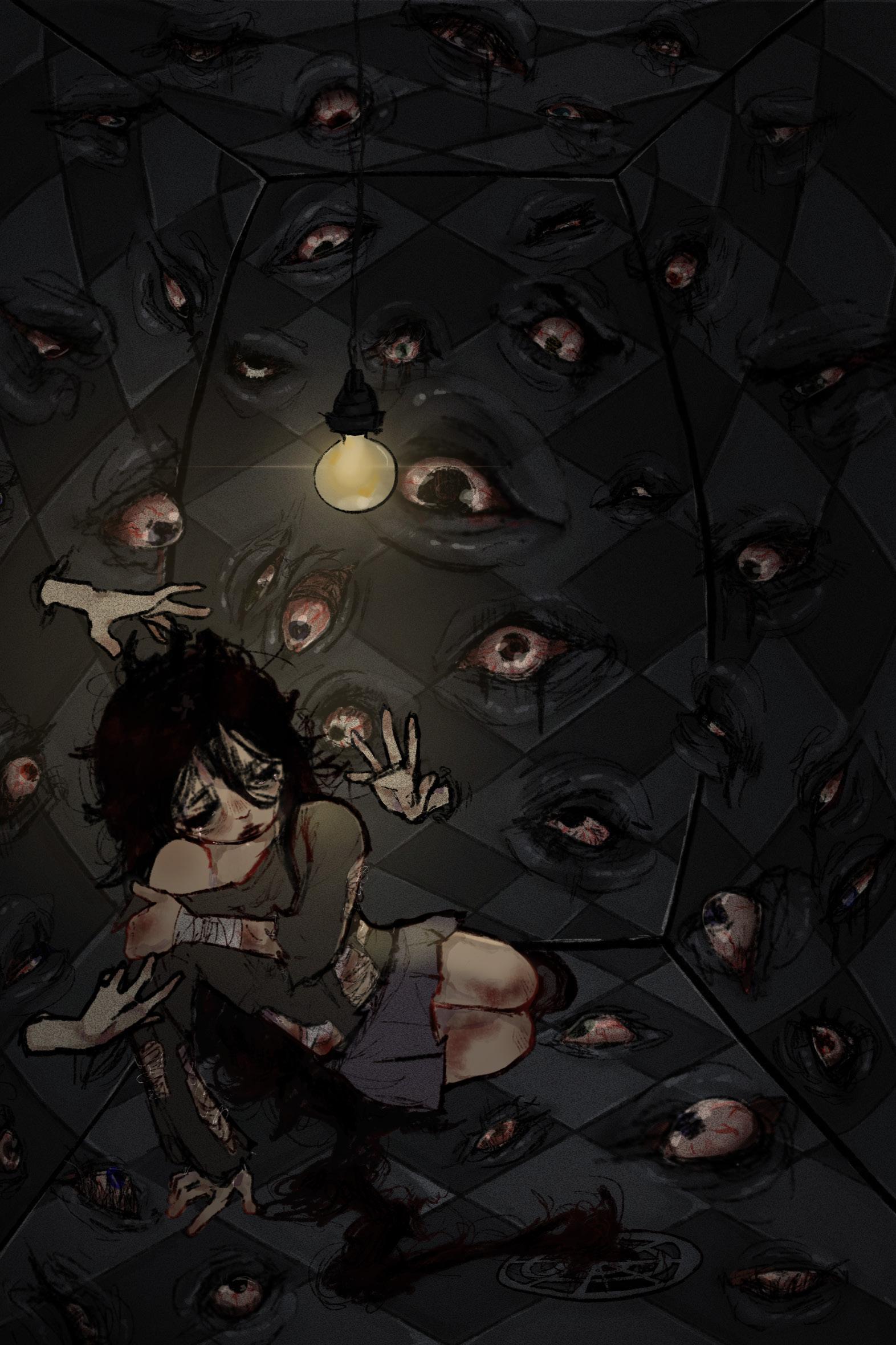
go on, fulfill the fantasy. spin around and fill up my hands. look! underneath the stucco— the fingernails you painted over

light at the end of the tunnel blisters your skin, peel, peel away bit by bit. what are you searching for? stay a while.
inhale the dust and dirt: get down to business. Shut up and take it.
Design by Ashley Luong
FEM2023 14






15
Design by Kaycee Stiemke
closest to you.

Those with a lack of appreciation for differing perspectives will kid themselves as a “painter,” a harborer of beauty if only to reinforce the status quo — judging and reducing you to characteristics that dare to






from your depths only to face a wall higher from which you can climb. A dismissal of your emotions, excitement, sadness, or anger, as painful as a vacuum consuming and disparaging your entire existence, executed by a loved confidante. When you are a Black woman, you learn to trust

anticipation in your eyes for the next few sentences. With a mind faster than your mouth, you feel great satisfaction being able to speak without filters, yet you cannot seem to make eye contact with anyone. If you met their gaze, you know you would slowly retreat toward the broken cage and desperately try to rearrange the lingering glass shards.
Enraged and Offended, Mad, Black Woman.
Water, quiet, like unspoken words, drips. Eyes spill out underneath the melting clouds.
A lone figure stands in the rain.
Is it you? The one with the folded um-





Welcome
We
 by Noor Hassan,
by Coral Utnehmer
by Mariah Hernandez, design by Olivia Sieve
by Shreya Kollipara, design by Cassandra Sanchez
by Angela Patel,
Katherine Mara
by Noor Hassan,
by Coral Utnehmer
by Mariah Hernandez, design by Olivia Sieve
by Shreya Kollipara, design by Cassandra Sanchez
by Angela Patel,
Katherine Mara
FEM2023 18 CONTINUED
to the extended cut of the Rage Zine.
Enjoy.
Hath a lot More Fury Than a Woman Scorned...........................................................................19
hope you continue to find and explore rage in these pieces.
Hell
Radio Playlist (Extended Cut)........................23
Gonna Gone Girl Myself.......................................27
design
Rage
I’m
of the Unpaid intern...........................................30
Collage (Extended Cut).......................35
from a Week of Rage.......................................37
Rage
Photoshoot
Notes
design by
“Hell Hath a lot More Fury an a Woman Scorned” “Hell Hath a lot More Fury Than a Woman Scorned”
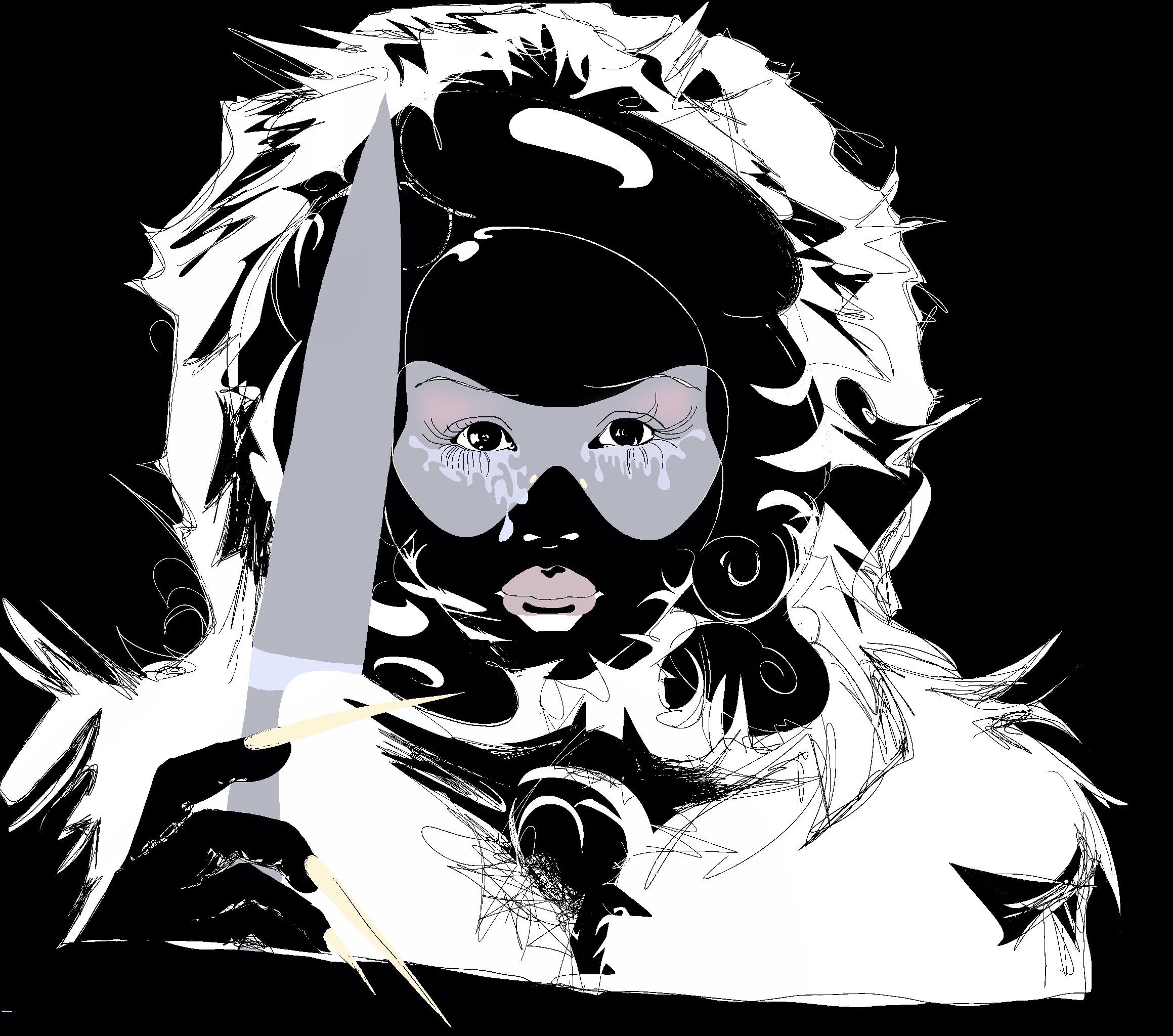 By Noor Hasan
Content warning: Gender-based violence, gun violence, transphobia
By Noor Hasan
Content warning: Gender-based violence, gun violence, transphobia
The trope of a scorned woman is addictive. A woman who is weak and insecure at the hands of a man’s rejection has become almost entertaining in nature. The vulnerability of rejection in this lens is a hot storyline because we can afford to view a compromised woman in this fashion safely. The actual threat of a violent return is nearly unfounded. The opposite, however — a man who is rejected by a woman and responds with physical threat — is not so few and far.
The dangerous results of refusing men’s unwanted advances only grow more life-threatening for BIPOC, transgender folks, and nonbinary individuals who are increasingly susceptible to violence on the basis of race and gender identity. The entitlement of misogyny has led to a fear of laying boundaries, establishing new norms of comfortability, and simply saying no.
UCLA’s School of Law indicates that transgender individuals are about “four times more likely” than their cis counterparts to be subjected to
“violent victimization.” This ranges from sexual assault to aggravated violence, both of which create a dangerous gateway for suicide attempts and ideation by survivors. Nonbinary and transgender individuals are subject to dehumanizing fetishization, and their attempts to reject the overwhelmingly transmisogynistic advances of men are exceedingly — and violently — ignored. In part, this is due to a key point discussed by the ACLU: the legal system continues to fail trans and nonbinary individuals (and especially BIPOC), with law enforcement often becoming the source of more sexual and physical violence. Rejecting sexual advances has created a cycle of erroneously criminalizing transgender and nonbinary individuals.
The result of rejecting a man’s advances can quickly and easily turn violent, and at times, deadly. However, femicide and sexism rooted in incel culture is no novel discovery. Studies indicate that about six women die each hour globally at the hands of men, often one they already know. Society has grown so dangerous for women that the mere act of rejecting a man begets
19
the potential of physical or linguistic violence. In fact, scholarship has coined a term for this phenomenon.
Lily Katherine Thacker describes this as “rejection violence,” which links components of toxic masculinity and fragility to the violent reactions of men towards women who have rejected their advances. According to a study spanning from 2016 to 2020, nearly 80% of gun deaths between intimate partners
targeted women, with the overall number only increasing each year.
Yet, for centuries, perceived femininity has been tied to (arguably) the most famous non-Shakespearean piece of dialogue that argues the complete opposite of explicit statistics. Traditionally, entertainment has copiously labeled women as the hostile, violent, and deadly force towards any signs of rejection

FEM2023 20
Design by Coral Utnehmer
far greater than men. Playwright William Congreve’s tragedy “The Mourning Bride’’ is the source of one of the most notorious quotes on the emotional volatility of women. The lead character, Zara, ends the third act of the tragedy with the line, “Heav’n has no Rage, like Love to Hatred turn’d, Nor Hell a Fury, like a Woman scorn’d.” Engraved on mugs, used as performative feminist jargon, and even inspiring the titles of books and movies, to say Congreve’s claim on the rage of a romantically rejected woman has enriched and guided modern sexism would be a gross understatement. Congreve successfully contributed to making the violent image of a scorned woman an entire genre, in an almost poetic and wise fashion.
Repercussions of the quote has, whether intentionally or not, inspired female characters in notable works like Stephen King’s novel “Misery.” Take the film adaptation of the novel, for example. Annie Wilkes, a former nurse, finds her idol, author Paul Sheldon, the victim of a car accident and rescues him, nursing him back to health in her home. It becomes clear that Annie Wilkes is not simply in love with Sheldon for just his writing, but for his aura and personality. She begins to rely on his dependency as her source of happiness and sanity. Throughout the film, as her adoration for him grows, he continues to politely reject her, until finally all hell quite literally breaks loose and she spirals into insanity. Now, do not get
me wrong – Annie Wilkes clearly indicates symptoms of sociopathy by breaking Sheldon’s legs, yelling at him repeatedly, and confining him through locked doors; all done to prevent him from physically leaving her home. But the film creates an explicit connection between Annie’s pure spiral of insanity and male rejection, firstly from her former husband (who had divorced her), and secondly from Sheldon. Directed by Rob Reiner, and written by Stephen King, both of whom are men, the film and novel – although sound masterpieces – are a great example of the “scorned woman” becoming an entertaining genre that continues to be capitalized upon.
Entertainment has worked for centuries to minimize female rage and anger so that it is most insatiable when women are rejected by men. It is through this rejection that women’s rage is the most valid, the most entertaining, and in no serious undertaking, mightier than the wrath of hell itself. Even in more nuanced films which aim to encapsulate feminine rage, most notably Quentin Tarantino’s “Kill Bill” Volumes, feminine rage is generally portrayed as being erratically violent and caused, in-part, by some form of male-rejection. Simply known as “the bride” in “Kill Bill Volume 1,” the film’s protagonist, Beatrix, is brutally beaten by assassins and shot at her wedding by her male partner, Bill. The Bride then goes on a vengeful path, killing each and every assassin (plus those who get in her way) that took part in her brutal beating and
–
21
attempted murder until finally (in a later Volume) she kills Bill. It is important to consider the key feminine symbolism of the film. Beatrix is nearly killed at her own wedding by the groom, all while pregnant with his child. Much (arguably most) of her anger is connected to mourning the loss of her child caused by the sheer violence of Bill and the assassins (we later discover the child is alive).“Kill Bill” traces key stereotypical “milestones” of a woman’s life – a wedding with a beaming bride dressed in white, and pregnancy. It is the violent threats to these institutions and to Beatrix’s life in general that supercharges her rage against her partner, Bill. But the likelihood of Annie Wilkes’ complete violent breakdown, or Beatrix’s vengeful murderous path, as established statistically, are far from reality.
Congreve’s reductive claim from “The Mourning Bride” paved the way for generalizations of women and how they internalize and display feelings of rage. But what really are the legitimate and key sources of women’s rage? The American Psychological Association points to a study quite literally called “the Women’s Anger Study,” which found that the three primary sources of women’s rage are “powerlessness, injustice, and the irresponsibility of others,” none of which hold any relation to being rejected by men. Rather, the sexist claim over the entirety of feminine rage by Congreve holds no scientific grounding at all. Scientifically speaking, women express their rage to mourn
the structural inaction of others. The patriarchal desire of men –of a husband – to be the central framework of women’s lives gave way to the quote. The patriarchy demands a heteronormative life to be the single most important development for women, so when men reject women and leave them scorned, it threatens their purpose to simply exist. Under the patriarchy, women’s largest source of anger is not the initial sting of being rejected by men, but the fact that rejection leaves women in the patriarchy incomplete – purposeless without a Bill for them to kill.
FEM2023 22
1 Kill Bill by SZA
RAGE RADIO RAGE RADIO RAGE RADIO
2Army of Me by Bjork
3
Amber Stevens
SZA’s sophomore album SOS features another deeply vulnerable tracklist, but delves into a more fresh and relentless emotion than her debut: rage. In “Kill Bill,” SZA uses lyrics: “I might kill my ex, not the best idea/His new girlfriend’s next, how’d I get here?” in order to express her pent up anger and feelings of jealousy. Debuting at #1 on the Billboard Global 200, “Kill Bill”’s raw emotion touched millions world wide, as people related to SZA’s feelings of delusion and wrath in the aftermath of a traumatic relationship. Tapping into her own ego, “Kill Bill” delivers realness and rage in a way that is unforeseen.
Bjork takes no prisoners. “Army of Me,” the debut single from her second solo album, Post, is filled with a cold, alienating, and unforgiving kind of a rage. There’s no fire and fury behind Bjork’s chant-like chorus—“If you complain once more, you’ll meet an army of me”—just nuclear-winter-cold frustration and disappointment. The heavy drums, bass, and synth are industrial, impersonal, harsh, and powerful. This track makes you feel that power, the magnitude and bitter strength that you feel in those moments where you’re just overwhelmed, overloaded, brimming with anger. As Bjork herself put it, “I’m a polar bear and I’m with five hundred polar bears, just tramping over a city.”
Elsa Servantez
Under the Table by Fiona Apple
Apple’s “Under the Table” details how her dinner date “says something that makes [her] start to simmer” and that they can “kick [her] under the table all [they] want, [but she] won’t shut up.” Fed up with condescending tones and biting her tongue, Apple calls out her date and the patriarchy for limiting her power to feel angry and say something about it! The witful language and metaphors within the song reverses outdated gender norms subverts the power dynamic. Apple empowers listeners to speak their truth and their rage, as nothing, even “that fancy wine won’t put this fire out.”
Amber Stevens
RadioRage RadioRage RadioRage RadioRage RadioRage RadioRage
23
4 Brand New City by
Mitski
The third track on Mitski’s debut album, Lush, “Brand New City” introduces a passionate anthem of rage. Perhaps the most iconic lyrics of the song, “But if I gave up on being pretty, I wouldn’t know how to be alive,” resonates with many women. I’m sure we all know how it feels to have so much of our worth placed on our looks and our youth. Mitski verbalizes these feelings over a crunchy guitar and drums; a different sound from her usual acoustic guitar and piano. “Brand New City” encapsulates the fear of aging and ugliness that has been impressed upon women since they were girls, portraying the rage that most of us feel for having to live in a world like this.
5 Differences
by Baby Tate
Emily Haddad
What does it mean to be That Bitch? A question that many successful and talented women may ask themselves is answered by rapper Baby Tate in her song Differences. On the surface, the track is about how Tate knows she is better than others who try to compare themselves to her. Her post-chorus addresses these wannabes with the statement “Bitch look at you, look at me, I know that you see the difference”. However, on a deeper level, her excessive pride is just an enraged expression of her confidence.
Tate’s lyrics speak to a self-assurance that others try to tear down out of envy, self-consciousness, or bigotry and remind you that their comments should not bring you down to their level but instead reinforce your own self-worth. Women and especially WOC people are constantly scorned for their confidence, but in the face of negativity, Tate responds with unshaken pride in her career, her blackness, and her ownership over her body. Though you can’t be on Baby Tate’s level, this song invites you to not give a fuck and be That Bitch proudly.
Leah Hartwell
RadioRage RadioRage RadioRage RadioRage RadioRage RadioRage RADIO PLAYLIST RADIO PLAYLIST RADIO PLAYLIST FEM2023 24
Not Nice by Megan Thee Stallion
Not Nice is featured on Megan Thee Stallions’ latest album Traumazine which largely discusses her struggle as a black woman after her assault from Tory Lanez and the attacks she received from the media and rap community following. This particular song speaks on the experience of women of color who have been exhausted of their kindness and struggle to be respected by others. Megan opens the song by talking about an unnamed person who she once took care of but did her wrong then explains how her skin color, dialect, and body type make others “not give a fuck” about her. After all she has been through, she takes her time to read everyone for filth and warn them that she is done being nice. Her song is both one of rage for everything and everyone who has made her so bitter but also empowerment that she won’t let others take advantage of her again. Megan Thee Stallion is a living example of “the best revenge is massive success.”
Bust Your Windows
by Jazmine Sullivan
Leah Hartwell
NDA by Megan thee Stallion
NDA by Megan thee stallion is the perfect song for this addition, because it is a song about resilience, and standing up for yourself at all costs. Black women know all too well the ways we are limited by stereotypes, held to impossible standards and shamed for our sexuality and the media’s response to Megan thee Stallions trauma is emblematic of this. In the end though she got her justice, from not only Tory Lanez, but also those who tore her down at her lowest. In the words of Megan “You gon’ have to pay me forever trying to be corny”
Alexus Torres
Off of her debut album Fearless, Sullivan encompasses the perfection of rage and just how sweet revenge is. Accompanied with emotional violins and a rhythmic percussion, Sullivan uses amazing vocals to express the anger of finding out your significant other is unfaithful. Sullivan, refusing to wallow in her misery, decides that it is time to take direct action and “bust the windows out your car.” As Sullivan explains, even though the satisfaction of physically expressing rage only lasted a little bit, it sure does make us smile.
Tia Barfield
7
8
6
RadioRage RadioRage RadioRage RadioRage RadioRage RadioRage 25
9
Smack a Bitch by Rico
10
Nasty
I have to include this song in the playlist, because this song was my introduction to black women in the alt rock scene. This song is iconic and represents the artistic beauty of Black fem rage. Of all people on this Earth, black women have the most valid reasons to be angry, and yet our rage is the most vilified. This song allows me to tap into that part of myself. Tia Barfield
12
Boyish by Japanese Breakfast
“Boyish” from Japanese Breakfast’s 2017 album Soft Sounds from Another Planet is a sullen tale of the quiet rage a girl can feel when they don’t fit the beauty standards of men. Zauner writes this song to her male lover, who seems to only make Zauner feel worse and unimportant, despite how intense her feelings of adoration are for him.
Marie Olmedo
11Underrated Popstar by Alice Longyu Gao
“Underrated Popstar” is a loud diss to all the haters. Alice tells of the difficulties of starting off in the industry, and how enraging all the pressure of stardom can be in this fast-paced hyperpop song. Marie Olmedo
Rid of Me by PJ Harvey
This song from PJ Harvey’s 1993 album Rid of Me comes from an era in which women took the reigns of punk and grunge. “Rid of Me” is a striking portrayal of toxicity and jealousy that can manifest in a relationship. Its a song that goes from creeping and moody to full of revenge and rage is seconds, and the thrill of it is something you must experience. Marie
13
Olmedo
Boys a liar Pt. 2 by Pinkpantress (ft. Ice Spice)
This song is my anthem, and a long awaited collab between two of 2023’s favorite singers and public figures. Pinkpanthress once again gives us a sweet song about annoying boys, this time with Ice Spice adding her own vexations with “sneaky” guys. “Boys a liar Pt. 2” is about the age-old tale about the duplicity of men and the frustrating aftermath of not feeling “good enough” that women tend to feel when dating men.
RadioRage RadioRage RadioRage RadioRage RadioRage RadioRage FEM2023 26
IM GONNA GONE GIRL MYSELF
 By Mariah Hernandez
By Mariah Hernandez
But I’m not going to. Oh no, baby, let’s unpack this, because I promise I don’t possess murderous tendencies (or a cheating husband). And by “gone-girling myself,” I mean framing my husband for my own murder/disappearance.
It’s not like I don’t have my reasons (being done dirty by every man I’ve encountered, experiencing trauma I wouldn’t wish on my worst enemy, begging to be respected as a young Latina woman, constantly having to fight for a place at the table amongst a sea of white people here in university). If I did do it, would you blame me? Could you blame me?
You probably would and could. “What an extreme response,” you must be thinking. “Why would she do that? She’s an insane, evil bitch who deserves to be poked and picked at by demons *down there* for the rest of eternity.” [But would I really deserve to go to hell for retaliating against getting poked and picked at by the earthly human demons? Funny thing is, I don’t actually believe in hell, so my
motivation to not gone-girl myself and commit other atrocities isn’t rooted in the fear of being tortured. It’s much more simple than religious morality. I could be burnt to a crisp, but I never found pleasure in setting fire to the world.] Even if my religious morals didn’t prevent me from gone-girling myself, I’m a forgiving person — it’s not like I’m totally unreasonable. I do bad things sometimes and I know that it’s not because I’m a bad person. Hurt people hurt people; I say that all the time now. For those I do believe to be beyond redemption, my energy is not directed on plotting their downfall because they don’t deserve the energy. Plus, secretly, I trust that the fucked up things you do will haunt you and consume you until you find a way to make true peace with your soul. We deliver our own misery better than anyone can, so I refuse to lift a finger. Gone-girling myself would be too much work.
Sure, like any other woman, maybe it does feel a bit cathartic to watch women take violent revenge on men by placing their paralyzed
27
body in a bear skin inside a burning yellow building, by axe-murdering the movie theater employee who has a crush on her, or, of course, like our beloved Amy Dunne gonegirling herself. But I will not be celebrated amongst these blonde white women holding the bloodied knife with remnants of the innards of their lovers.
I can’t say this enough: I don’t want to do it. I don’t. But with these violent role models, no wonder why I’m at a loss. I’ve tried the traditional healthy way, communicating my anger, my hurt, pleading with someone to hear me out. But yet, I am the crazy one.
I don’t have a singular cheating husband, but I do have repeating patterns within the men I encounter. I tell them in bed that I’m crazy — in the sense that I will confront him if I feel disrespected and in the sense that I have 3 separate prescriptions for my psyche on my nightstand. Innocently, they look up smirking saying that they know. With the glimmer of opportunity in his eyes, I know he’s thinking that it’s so cute and freaky. Yes, it is so fun when we’re in our honeymoon phase. But I know it as well as any of you, that it never lasts: they unzip the nice guy exterior to reveal a sociopath who pretends that I never even existed.
You can try to kick me off the cliff of obsoleteness to your own personal graveyard full of women you got bored of, and sure, maybe you’ll succeed. I sure as hell won’t go
down without a (nonphysical) fight though. I tell them it’s hurtful or act out until my voice gets raspy from screaming. I get crazy. Wouldn’t you? Being betrayed by a person who I talked to about family and bell hooks and questions that made me feel like I was knowing them deeply, you expect me not to be crazy? No, that’s when craziness isn’t so cute anymore, when I remind them that I’m an actual person with feelings and not the manic pixie dream girl. “I have no idea why you’re acting like this.” You know. You just never listened.
That’s but one of the many repeating cycles of torture in my life. I’m losing my sanity out here, I can’t help but hear “I WANNA GONE
GIRL MYSELF” screaming bloody rage in my intrusive thoughts. You don’t know how hard I’m trying.
I’ve tried the therapy thing too, but do you know how futile it feels when no one else cares to? Everyone agrees that yes, I need and should go to therapy, but never seems to ask themselves if they should as well. It’s so passive, and yet that’s what makes me feel like my head is being held under water. I lose my oxygen and patience, and bitterness and deadness settles into my bloodstream. This is really when gone-girling myself seems valid. No amount of training for this marathon of misery, no amount of therapy, no amount of forgiveness can truly help. All I can do is accept that I can’t do a thing about it and pretend that’s peace, but everything hurts just the same. That’s
FEM2023 28
how I know gone-girling myself would not accomplish anything.
You know what happens when I’m virtually screaming for help and for someone to end the pain? I’m told to forgive people for the hurt they’ve caused me. I’m told to just remember I’m more mature and I’m above being bothered by this. That’s what drives me the craziest, maybe the most irrational a person can get: the expectation that I am to send a white dove of forgiveness just for remorseless people to squeeze the delicate little body until its head pops off and white feathers run red. I am crazy and cruel enough to refuse to senselessly send them to their deaths.
So “IM GONNA GONE GIRL MYSELF” continues to echo through
my enraged soul. It started out as a tolerable spiky weight that floats in my stomach acid, but now everything has gone nuclear with all the toxic shit forced down my throat. Hit me and I might explode, guts flying on everyone I love and hate with no sense or rationality. And the worst part? My externally-inflicted destruction leaves me with nothing.
So, for now, I’ll keep taking it. Some scabs have healed and faded into lightning shaped scars, and some are still being clawed off to bleed underneath my fingernails.
I don’t want to gone-girl myself. Don’t make me do it. Please just tell me that if I were to gone-girl myself that you might whisper, “I understand,” or maybe even “Good for her.”

29
Design by Olivia Sieve
Rage of the Unpaid Intern
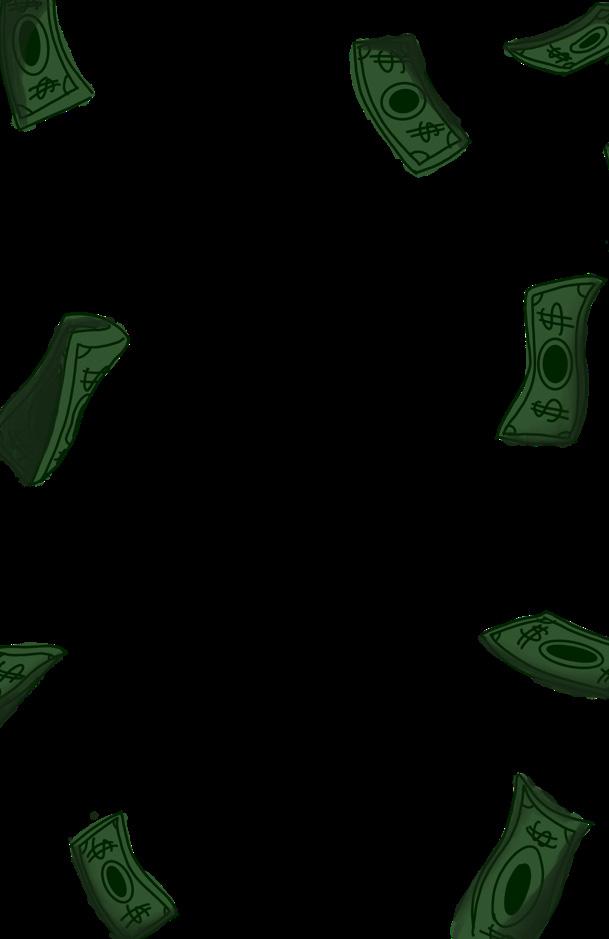
 By Shreya Kollipara
By Shreya Kollipara
The unpaid internship is a tale as old as time on college campuses across the country, a sacred rite of passage before one enters our capitalistic hellscape – I mean, booming American economy (cough cough). But as an intern who’s done her fair share of labor (with enough experience to warrant a mere comment, or even a whole article), I am dying to know why my contributions as a student do not deserve to be compensated if they are so dearly necessary. Why have we normalized unpaid work in so many industries, and what makes it any different from exploitative labor practices abroad which we are so quick to criticize? The flowery concept of an internship draws students into a cosmopolitan mirage, a world where exploitation under the premise of “building your resume,” “gaining experience,” or “paying your dues” is justified and even reasonable. Unfortunately, unpaid internships exacerbate inequities even as graduating students enter the workforce, and ironically enough disproportionately affect those students who cannot afford to do unpaid work in the first place. I interviewed students at UCLA who have worked as unpaid interns in different fields, drawing from their experiences and rage to inform my
own.
Before delving into the anecdotal, let’s consider the significant body of research pointing to the prevalence and unpopularity of unpaid internships nationally. University of Wisconsin-Madison’s Centre for Research on College-Workforce Transitions estimates that roughly 31% to 58% of internships do not pay in the United States. Another study shows that 43% of internships at for-profit companies are unpaid. The National Association of Colleges and Employers (NACE) also conducted a study in the spring of 2019 to analyze the internship experiences of 4000 seniors across 470 member universities and colleges, and found that: i) Hispanic and Latino students were more likely than any other racial group to not have interned prior to graduation, ii) Women made up 81% of unpaid interns despite 74% of the survey respondents identifying as women, and iii) First-generation college students only represented 19% of all paid interns even though they made up 22% of survey respondents — and more than a quarter of these first-generation students had never worked an internship. One of the conclusions drawn from this
FEM2023 30
survey was that students with paid internship experience tend to perform better in job fairs and receive more job offers. And why would they not? Similar research shows that nearly 80% of all employees at the Big Four accounting firms have previous internship experience, and this trend most definitely extends to larger tech companies such as Google and Facebook.
Despite deviously deepening existing social and economic divisions, the unpaid internship makes students vulnerable, tricking them with resume candy like Hansel and Gretel’s infamous Gingerbread Hag.
much as other employees) are susceptible to racial and/or disability dis crimination, ex ploitation, and sexual harass ment. “When you’re not get ting paid, in essence, [you] have no protec tions. For the protection of the individual, people need to pay” says Vera. Unpaid interns are not eligible for federal workplace protections, much less any accommodations un der the Americans with Disabilities Act; while a few states like New York have initiated some protections for unpaid interns, many have not.



The legality of unpaid internships is also lost in gray area, unclear and exception-ridden. According to the Fair Labor Standards Act, unpaid internships are only legal if the in tern is the primary beneficiary of the settlement, which is determined by a seven-point test (this is only appli cable to for-profit companies, since public sector and nonprofit orga nizations are held to different stan

31
Design by Cassandra Sanchez
dards). These guidelines become more elusive for international students without authorization to work in the U.S.; an intern still must be the primary beneficiary but their inability to be appropriately compensated does not give employers a legal loophole. In fact, if the terms of their internship violates the FLSA, they could be breaching the terms of their immigration status and risk deportation. An international student I spoke to, M, told me that to receive the Curricular Practical Training (CPT) work authorisation (i.e. the state authorisation required for students on F-1 visa programs to pursue any practical work experience) she had to enroll in a 2-unit “shell” summer class at UCLA called “Internship Studies.” Although UCLA itself has no role in helping international students find internships, the class requires students to write a two-page report at the end of their summer and pay the summer quarter’s exorbitant tuition and campus fees just to stay and work in the U.S. legally.


Other UCLA students I interviewed discussed their unpaid internship experiences with me, showcasing how these positions allow for exploitation and/or unfair treatment across all industries. My friend J was recently hired as a Fashion Design intern for a popular fashion designer and celebrity stylist in Los Angeles; she mentioned that most of her work involves doing the “dirty work,” including organizing, scheduling, picking things up, and dropping things off using her own car (and here’s a bonus: they don’t pay for her gas). Although she ac-
knowledges relevant takeaways from the work, she says that her workload and responsibilities were unprecedented – especially due to the lack of compensation – and that the fashion industry is unfortunately largely held up by unpaid labor because “if you want it badly enough, you’ll do it for free.” And if she didn’t work the job, somebody else would. Another student M, who works as a legal assistant in the public sector, talked to me about how strangely structured the legal field in the U.S. is — although paid positions rarely exist at the undergraduate level, work experience is still expected (despite not being officially required) when applying to law school, even though you may not be very useful without an LLM / J.D. degree. She also notes that the legal profession is heavily characterized by dominance and office hierarchies; a social barrier tends to separate interns, paralegals, and attorneys in the office, explaining why she is routinely referred to as “intern” instead of her name, and how disrespect and exploitation are embedded in legal office culture.
Interestingly, unpaid internships are largely concentrated in (although not limited to) a few fields — government/public sector, politics, fashion, research, nonprofit organizations and other altruistic work. In a Teen Vogue interview, Massachusetts representative Ayanna Pressley discusses how unpaid labor under the guise of experience is all too common: “In politics, working for free was the norm.” Funnily enough, the White House only recently announced that it will be offering

FEM2023 32
also require those studying journalism, education, or social work to complete field work that is almost always uncompensated. However, many organizations in these fields provide such contested opportunities because they cannot afford to pay student workers to begin with, pointing to larger issues of equity that go beyond this conversation.

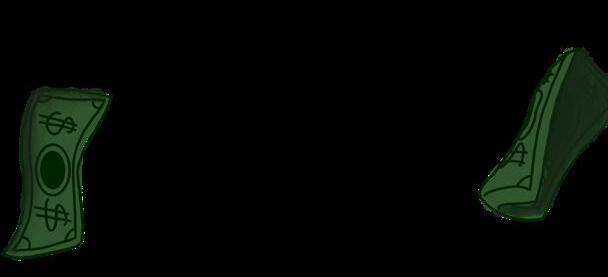

A player that is somehow conveniently overlooked throughout this discussion is higher education institutions. When a student works an unpaid internship to receive credit, their employer does not provide said credit, the university does. Technically, students pay tuition for “credit,” although no classroom or professor is required — so you are paying to take time away from school, a social life, and other responsibilities to then work a job that will not return the favour! Make it make sense! In the same interview with Vera, he mentions how such arrangements provide employers with legal cover, and that “Universities are staying quiet because it’s an additional revenue stream for them at the expense of their own students.” I interviewed two students who mentioned receiving academic credit at UCLA instead of actual payment for their work; one student, K, worked at a talent management agency and was required to be oncall 19-28 hours a week (depending on the week), and another friend, M, works for a mechanical engineering
What this modern market has failed to realise, or even conveniently taken advantage of, is the fact that working for free still comes at a cost — it is only a question of who can bear it. With student debt on the rise like never before, is this a game we’re still playing?
Naturally, these consequences disproportionately affect low-income students of color who are already subject to the burden of paying their student loans. Women are also further liable to additional economic difficulties given the gender wage gap and the issue of unpaid household labor being predominantly tackled by women. Moreover, the role that race, class, gender, sexuality, ability, and economic privilege play in being able to i) receive an internship offer, and ii) afford to work an unpaid internship is an indispensable part of the problem. Another NACE study conducted between 2020 and 2021 showed how the majority of students working unpaid internships identified as white men. The unwillingness or inability to compensate students for their labor is a direct barrier to entry, exacerbating generational wealth gaps and hindering social and economic mobility. The price of unpaid work is the opportunity cost of working elsewhere simply to make ends meet, but a larger disadvantage presents itself when students without the financial security to work such positions graduate

33
and find themselves lacking the required industry experience to move forward. In this way, a cycle emerges: financially comfortable students are rewarded with resumes filled to the brim, and low-income students are confronted by an increasingly competitive job market that is still stuck in its delusion of meritocracy.
The graduating workforce today is welcomed by a new and improved set of obstacles, including relentless “degree inflation” or even “experience inflation” (the inflation of candidate qualifications and requirements) for what are supposed to be entry-level jobs. An interesting solution emerging through discourse is the introduction of paid apprenticeships, or even micro-internships. A paid apprenticeship would include a similar scope of responsibilities as a full-time role post graduation, allowing for a more accommodating transition while providing much-needed experience and knowledge. A micro-internship is a short-term role offered to undergraduates, allowing students to build transferable skills, take advantage of other opportunities, and most importantly, be compensated; Parker Dewey is a company that is actively working with college career centers to make micro-internships accessible!
Another approach to eliminating this barrier — or at least to successfully mitigate its consequences — is legislation. A measure being considered in California includes $5 million in funding to provide stipends to 650 low-income students

and graduates working unpaid internships at the State Department (Why can’t they just start paying their interns? Ask the White House). New York labor laws also include specific stipulations regarding internships that make it virtually impossible for employers to profit from unpaid work. We’re not where we need to be, but at least that’s a start.
So, what now? Do you take that sexy unpaid internship or worry about never finding a job? A recommendation I’ve come across is reaching out to your employer for a minimum stipend to pay for food and travel, if you can afford to work the job. Some schools also provide smaller grants for students working unpaid jobs! Unfortunately, my rage is not consequential — this is something that is bigger than me, bigger than us. Even in my critique of the concept, I must acknowledge the privilege I’ve held to accept such work in the past and perpetuate inequity in the labor market. But student worker strikes across campus have shown us that one way to bridge the gap is to start the conversation. I can hardly expect Will Smith to slither out of a golden lamp and drop a stipend into my lap, but I can definitely ask why the government won’t.


FEM2023 34
RAGE RAGE RAGE RAGE RAGE RAGE 35
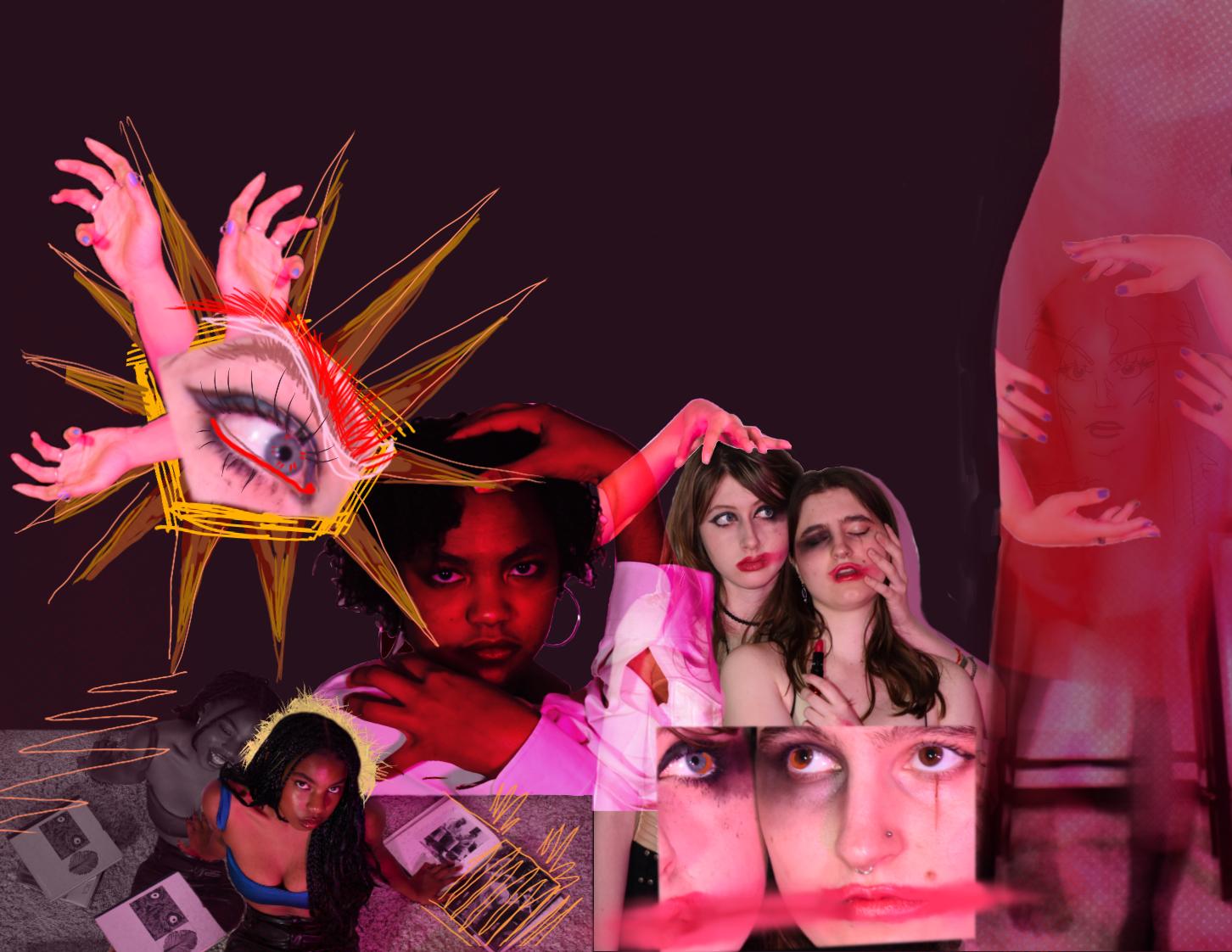
RAGE RAGE RAGE RAGE RAGE RAGE
RAGE RAGE RAGE RAGE RAGE RAGE
RAGE RAGE RAGE RAGE RAGE RAGE
fuel. your. RAGE!
RAGE RAGE RAGE RAGE RAGE RAGE

RAGE RAGE RAGE RAGE RAGE RAGE 36
NOTES FROM A WEEK OF RAGE
By Angela Patel
This essay emerges from a lifetime of emotions, but more specifically from a week during which I set out with the intention of feeling and focusing on the emotions that I usually try to suppress. These are my notes from a week of rage — a political and therapeutic exercise of emotion.
Day 1
I’m angry that I have to get up today. I woke up feeling like shit and I don’t want to be a human. If feeling these feelings means that I’m going to stew in self-pitying grumpiness all day, then so be it. Being grumpy in the presence of others isn’t always so easy. I’m often hyper-aware of how my emotions could potentially be affecting those around me, and I worry that by coming off as angry or upset I am signaling to my peers that I don’t care about them. I even start to worry that my worries about how I’m being perceived are irrational.
Being the mentally ill queer that I am, my emotions are not exactly stable. On any given day, I employ a variety of tactics to distract myself from some of the less pleasant emotions: virtual escapism, overworking myself, delusional daydreaming, the occasional drug use.
Healthy distractions are good, my therapist tells me, as long as you’re letting yourself feel your feelings most of the time.
Feeling feelings, setting boundaries, advocating for oneself are all “healthy” behaviors that don’t come easily to me. Unfortunately, these difficulties are some of the common symptoms of being raised as a girl.
The tricky thing about rage is that it’s a political emotion, not just a personal one. Feminist rage has historically been policed and dismissed as an overreaction to a problem that doesn’t exist.
In our society, men are the angry and assertive gender. And while certain groups, such as Black and Latina women, have been stereotyped as overly aggressive or “spicy,” this rage masculinizes these women, dehumanizes them and denies their femininity. Rage is almost never associated with womanhood in positive or empowering ways.
Instead, women feeling or expressing strong emotions are called “crazy,” “insane,” or “hysterical.” Those in power want us to believe that we’re beyond the days of patholo-
37
gizing feminine hysteria and feminist rage, that we’ve even moved on to celebrating powerful and emotional women. But like so many other aspects of the patriarchy, society continues to minimize and vilify our emotions in subtle yet pervasive ways.
Because we are taught to associate emotion with the opposite of reason, we see rage as inherently irrational. Not surprisingly, this is connected to narratives that position womanhood and non-white personhood as stuck within the realm of emotion rather than the supposedly far superior realm of reason and intellect.
Rationality is a bunch of patriarchal bullshit. Pitting feminized and racialized emotions against reason (usually embodied by some glorified white man) creates a harmful paradigm in which anything and anyone that does not conform to privileged logics is relegated to the margins. Normality, sanity, legality and other privileged statuses of being, despite being subjective and harmful, continue to be the standards by which we are expected to measure ourselves.
To attempt to make feminism, anti-racism, and anti-capitalism about rationality is to appeal to a white masculine ideology. The interlocking systems of patriarchal domination, white supremacy, imperialism, ableism, genocide, transphobia, homophobia, and other structures of power have always been based on logics that do not acknowledge the feelings and the humanity of the
oppressed.
Society treats our anger as something that needs to be worked through, therapized, medicated. My rage is unspeakable. My rage is a rage that the world does not care about except to deny and suppress it.
Day 2
I’m angry that I feel the need to appeal to those in positions of power and guard myself against their unpredictable emotions. I spent my entire childhood hiding myself away from emotionally immature parents, and some days it feels like I’m back there with my professors. These are the professors (usually white men — shocking) that make it clear from the start that they look down on their students and are unwilling to change. The number of times that I’ve had to put up with cruel and indifferent professors, and felt unsafe to speak up against them, is unfortunately too many.
In this institutional setting, power imbalances give rise to inequalities of emotional legitimacy. White male anger is and always has been legitimized. White male anger has been the foundation of empires, religions, universities and countless dominant ideologies.
What white male anger and white male ‘rationality’ cannot give birth to is a world which fully acknowledges what has been cast aside as feminine, as racially inferior, as queer, less-than-human and “oth-
FEM2023 38
To center the margins means centering emotion and irrationality.
It does and should make us enraged to grow up in this world. Where that rage goes matters; what it creates and destroys matters.
Unfortunately, marginalized people, especially multiply marginalized people working within movements that may exclude them, have to be aware of who and what their rage upsets. Allyship and solidarity become essential when expressing rage threatens the livelihoods of those who feel it.
When my tenured white male professor deliberately creates an unsafe learning environment, I feel as though my rage must be made respectable, that I must go through the “proper channels” if I want to be heard. I feel fear. I cannot be sure that my fellow classmates will support me. As a result, I do nothing (except feel angry).
The burden of speaking out should not be placed solely on the victims of injustice. At the same time, though, it can be enraging to to have to hold back, to silence yourself and let someone else speak for you. Some days I’m not sure what’s greater: my rage or my fear.
What do we do when the only rage we know is the white male rage that has been physically and psychologically beaten into us? The white man, who is obsessed with what
he thinks he deserves and what he believes “the left” is trying to take away from him — coercive sex with women, exploitative labor practices, the uncontrolled freedom to be racist, sexist, transphobic, xenophobic, etc. — is so often the center of the narrative surrounding respectability and emotion.
White women act in subservience to this patriarchal anger when they use their whiteness, and often their class privilege, to approximate white masculinity by directing their rage at those below them. This behavior threatens feminist solidarity and creates a need for women and femmes of color to define themselves in opposition to white supremacy in all forms.
Oppressive institutions want us to feel like we are just another number in the system, and that we have no power to change anything. They count on us not talking about our feelings and needs, and they count on us not coming together in solidarity to respect and celebrate one another. An individual’s anger can be silenced, but the anger of a thousand people is a force that must be reckoned with.
Day 3
Often I feel troubled at my instinct to share my feelings on social media, especially when I’m struggling. Somewhere I picked up this idea that posting about my feelings of sadness and anger is a “cry for help” or “attention seeking,” and that these things are bad.
39 er.”
What if I do need help? What if I do need attention? Do we all not need and deserve this care?
Sharing emotional experiences is not only a vulnerable starting point to individual healing, it is a crucial part of recognizing that emotions are never only our own.
We are all part of something bigger than ourselves — and this empowers us. Our emotions are so frequently made out to be extremely individual — we write in our private little diaries, we vent to our therapists — but collective emotional experiences are so vital on both a personal and a communal level.
Especially in the current moment, it is very easy to feel disconnected from the world and become apathetic.
Apathy can be a coping mechanism when one feels unprepared to process suffering and feelings of powerlessness. Just like emotional connections can inspire us to take action and create, emotional disconnection can rip us away from the things we care about. For activists, an inability to balance the needs of the self with the needs of the collective can produce an apathetic void.
This void cannot be filled with rationality (“you should care about this because it affects this many people” and other similar statements). Emotional connection is what inspires us and urges us to keep going.
When I think about expressions of
rage, solidarity, and self-determination that transcend rationality, I think about Audre Lorde. I think about Riot grrrl and Queer punk and performance art. I think about Marsha P. Johnson and Sylvia Rivera. I think about all the people who died for liberation causes that are still being fought today.
As Audre Lorde famously said in her essay, “The Uses of Anger:”
“Every woman has a well-stocked arsenal of anger potentially useful against those oppressions, personal and institutional, which brought that anger into being. Focused with precision it can become a powerful source of energy serving progress and change. And when I speak of change, I do not mean a simple switch of positions or a temporary lessening of tensions, nor the ability to smile or feel good. I am speaking of a basic and radical alteration in all those assumptions underlining our lives.”
Lorde describes anger as a literal weapon–she does not think rage exists only to be seen or heard but to be felt and used as the basis for a major paradigm shift.
If we see our rage as individual, as something that must be worked through alone, therapized, and medicated, then we lose the potential of collective rage and power.
Many of us stop ourselves from speaking out about injustice because we are afraid that others will react with anger or misunderstanding.
FEM2023 40
What about our own rage? Doesn’t it deserve to be witnessed and heard and understood and acted upon?
Another Audre Lorde quote, one that is on a poster that hangs over my bed, says, “When we speak, we are afraid that our words will not be heard or welcomed. But when we are silent, we are still afraid. So it is better to speak.”
As a Black lesbian woman who spoke out in opposition to anti-Blackness and homophobia in the white feminist movement as well as capitalism, racism, and imperialism more broadly, Audre Lorde was not a stranger to what it meant to speak truth to power. Still, she believed anger was a necessary tool for radical change.
Day 4
Today I am trying to be nice to myself. It is usually easier for me to be nice to others. So, I want to let myself fail and make mistakes without self-judgment. I want to feel rage without turning it inwards and destroying myself.

Letting myself feel the rage that arises from existing in this world is a tool for understanding my own oppression. I think it can also be called .
The general understanding of selfcare has been warped by neoliberal capitalism and consumer culture.
Instead of recognizing one’s needs, especially those that may fly in the face of what a capitalistic society expects from the individual, selfcare has become synonymous with buying yourself shit that makes you temporarily happy. It’s all incredibly feminized and tied up in a lot of the same issues that all of consumer culture creates.
Men, especially cis-het able-bodied white men, are brought up to believe that they don’t need to take care of themselves because they will always have a woman (a mom, a girlfriend, a wife) to perform that emotional labor. Women, on the
41
design by Katherine Mara
other hand, are socialized to be experts in controlling their own emotions and managing their stresses on their own.
Material things can and do bring us genuine pleasure, but we also must step back and think about why “wellness” and “self-care” products are so heavily marketed towards
less, romanticized, pathologized, fetishized, vilified.
Rage, directed inwards, becomes self-destruction. It’s easier to hate yourself than to hate other people when you’ve never been allowed to express rage without getting rage in return, or when you’ve felt like an outcast your whole life.

Oppression and trauma shape our experiences of the world, and with that our emotional responses. Everything feels unstable, life-shattering, cataclysmic. Some days my rage manifests as a hatred for the world and everyone in it, especially myself. All I feel able to do is scream into my pillow (metaphorically and literally).
Today, though, I will be gentle to myself and allow myself to need love and care and an outlet for my anger. I deserve that much.
Day 5
young women. What about being a woman makes us so in need of being calmed, being soothed, being cared for by ourselves? Do we need a spa day or do we need revolution?
Self-care means not letting our rage be made individual, small, meaning-
One of the shitty things about gender is how you identify with your own body is so wrapped up in how you are perceived by others. Today I wanted to dress masc, and I had picked out the perfect outfit and was feeling the gender euphoria — until I walked out of the door and onto campus and was immediately met with strangers greeting me as “miss,” assuming my pronouns, and generally perceiving me
FEM2023 42
When I am walking down the street and someone tries to get my attention by calling me “ma’am,” I do feel rage. It’s easy to call this rage an overreaction, or to ignore this rage because it is less significant than other emotions, or to explain away my emotions with rational explanations. Similarly, for me to turn this rage inwards and tell myself that there is something wrong with me because of how the world perceives me is easy, albeit painful.
What is not easy is to let my rage at the world, at how ideologies and institutions allow for someone to misunderstand and hurt me in this way, become externalized, collectivized, and empowered.
Not all trauma has to be made into something useful and good. Not all rage has to be extraordinary. Rage can be petty, simple, straightforward, apparently meaningless. Sometimes shitty things are just shitty things. This is all true. But at least for myself, imagining how my individual emotional experiences are not just a reflection of my inability to maintain calm, or my failure to conform to what others expect of me, makes me feel better.
When friends affirm my gender identity, I feel joy in knowing that who I am can be understood and celebrated. When my pronouns are not only heard but used correctly, I feel safe and warm. Where there is great potential for pain, there is also the possibility of even greater love.
Day 6
Recently I’ve been thinking a lot about if there’s a right way to respond when someone bluntly disrespects you, whether out of hatred or ignorance. When that hurt and anger wells up inside of you, it has to go somewhere.
It’s not worth spending my energy on a response, I’ve often thought to myself when I see someone making an ignorant comment on social media. I feel a deep cynicism about being able to have a meaningful conversation on online platforms that are designed to spark conflict and elicit strong emotional reactions.
Is it ‘right’ to lash out against the trolls and the bigots and the assholes? Should you express anger at them, or at what they represent, even if doing so is unlikely to change their mind?
Philosopher Amia Srinivasan uses the term “affective injustice” to refer to the ways in which public expressions of rage are not equally accessible to everyone. Many women of color are forced to choose between suppressing their anger and expressing it to a world that is not willing or able to receive it.
Affective injustice is very apparent on social media. The Internet is not a utopia for the oppressed. Depending on one’s positionality, there are real dangers to existing openly online, especially if you are expressing rage against injustice.
43
a woman.
as
In the diss track, clap-back, internet drama-obsessed culture we inhabit, it might seem as though fueling the fire with anger is a sure way to get attention — and whether negative or positive, attention is money.
But femme-presenting people online are vulnerable to very real violence, including stalking, doxxing, and harassment. The mental and physical health toll that this violence has is significant. We are taught that harassment is just part of what it means to be a marginalized person online, and that expecting any less is naive.
Online hate is not just ignorant 15 year-olds on Youtube and minor celebrities beefing on Twitter. It is not just “cancel culture.”
In the face of violence, why do we expect marginalized people to respond “respectably?” Again, only certain public expressions of rage are considered legitimate and acceptable. People should be able to emotionally respond to those who are oppressing and attacking them without fear of even more violence. In cases like the overturning of Roe v. Wade, it’s perfectly acceptable for people to direct their anger at the conservative judges and politicians who are suppressing their bodily autonomy. Fuck ‘em. Concrete action does not happen without public outrage and anger.
Day 7
I hate toxic positivity. I hate people who refuse to discuss politics be-
cause it “brings down the vibes” or whatever. It is a privilege to be able to ignore politics. For many of us, our mere existence and livelihoods are political.
So yes, I will be angry. I will be sad. I will hurt and grieve and feel openly and loudly. I will tweet too much about my feelings. I will talk about uncomfortable things that will probably make others angry. I will hate.
I really wish that I could care less about making privileged people feel uncomfortable. In my fantasy, I call out every professor who refuses to acknowledge their students’ needs and experiences. I correct every stranger who misgenders me. I flip off every cop I see in the street.
Thankfully I don’t have to do it all on my own. It is enough for me to know that I am not the only one feeling all these emotions. Being able to witness moments of collective strength and outrage and joy lets me know that I am not something that needs to be therapized, medicated, or ‘selfcared’ into oblivion.
I am joyful, sad, stressed, tired, angry, excited, hopeful, and enraged. I am not alone in feeling all of these things. I am queer and neurodivergent and mixed race and genderfluid and mentally ill. I am part of communities of people I’ve never even met, and they know my rage and my joy and my exhaustion just as I know theirs. Fuck everyone who denies us our feelings!
FEM2023 44
x
Mar Escusa
Writers
Amanda La
Noor Hasan
Jalyn Wu
Marie Olmedo
Kaycee Stiemke
Gwendolyn Hill
Shreya Kollipara
Angela Patel
Mariah Hernandez
Editors
Tessa Fier
Sarah Huang
Lauren Vuong
Trisha Khattar
Amariyah Lane-Volz

Purva Joshi
Kayleigh Morrissey
Kimia Faroughi
Faith Forrest
Vanessa Diep
Angela Patel
Sabrina Ellis
Eva Speiser
Anouska Saraf
Najda Hadi-St John
Kelsey Chan
Julianne Estur
Dev Dharani
Talia Way-Marcant
Bianca Badajos
Managing Editor
Sophia Obregon
Designers
Katelynn Perez
Coral Utnehmer
Erin Choi
Ashley Luong
Cassandra Sanchez
Katherine Mara
Olivia Sieve
Photoshoot Crew
Cassandra Sanchez
Coral Utnehmer
Mar Escusa
Sophia Obregon
Olivia Sieve
Kailyn Barrera
Leah Hartwell
Cassidy Kohlenberger
Reika Goto
Photoshoot Cast
Gia Blakey
Sydney Shanne
Kaycee Stiemke
Emily Haddad
45
FEM, UCLA’s feminist newsmagazine since 1973, is dedicated to the empowerment of all people, the recognition of gender diversity, the dismantling of systems of oppression, and the application of intersectional feminist ideology for the liberation of all peoples. FEM operates within an anti-capitalist, anti-imperialist, anti-racist framework. Our organization seeks to challenge oppression based on sexuality, gender, race, class, ability, religion, and other power structures. We create a wide range of compassionate multimedia content that recenters narratives often rejected or ignored within mainstream media. Beyond journalism, FEM engages in actionable praxes by building coalitions with other campus and community members. As self-reflective feminists, we are committed to unlearning and relearning alongside our global audience as the sociopolitical landscape in which we are situated continues to transform.
@FEMNEWSMAG

ISSUU.COM/FEMNEWSMAG
FEM@MEDIA.UCLA.EDU























 by Gwendolyn Hill
by Gwendolyn Hill





















 By Noor Hasan
Content warning: Gender-based violence, gun violence, transphobia
By Noor Hasan
Content warning: Gender-based violence, gun violence, transphobia
 By Mariah Hernandez
By Mariah Hernandez




















